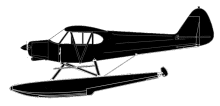
ASN Wikibase Occurrence # 297998
This information is added by users of ASN. Neither ASN nor the Flight Safety Foundation are responsible for the completeness or correctness of this information.
If you feel this information is incomplete or incorrect, you can submit corrected information.
| Date: | Friday 8 June 2018 |
| Time: | 19:00 LT |
| Type: |  Piper PA-18 |
| Owner/operator: | |
| Registration: | N1203A |
| MSN: | 18-811 |
| Year of manufacture: | 1951 |
| Total airframe hrs: | 2244 hours |
| Engine model: | Lycoming O-320 E2D |
| Fatalities: | Fatalities: / Occupants: 2 |
| Aircraft damage: | Substantial |
| Category: | Accident |
| Location: | Sitka, Alaska -
 United States of America United States of America
|
| Phase: | Manoeuvring (airshow, firefighting, ag.ops.) |
| Nature: | Private |
| Departure airport: | SITKA, AK (A29) |
| SITKA, AK (A29) | |
| Investigating agency: | NTSB |
| Confidence Rating: |
The pilot was flying a lodge client on a wildlife viewing flight in a floatplane. About 2 hours after the planned return time, the airplane was reported overdue and a search was coordinated. The airplane wreckage was located nose down in a confined shallow river the next day. The airplane did not have GPS, ADS-B or a recording system, and there was no radar coverage in the area of the accident; therefore, the flight track was unknown.
The airplane impacted the river bottom in a 70 ° nose down attitude with the front floats absorbing much of the energy and the aft fuselage displaced and twisted right, indicative of impact during a stall/spin. All flight controls were intact and continuous, and the engine exhibited no anomalies. The propeller blades exhibited rearward bends with torsional twist and some chordwise scrapes, and propeller strikes were evident on deadfall trees trunks at the initial impact site, which are all indications of impact with engine power. The right fuel tank cap was not located but given that there was evidence of engine power at impact, it is unlikely that fuel siphoning/exhaustion was causal. It is likely that the pilot was maneuvering the airplane in slow flight to show the passenger wildlife, and, in doing so, exceeded the airplane's critical angle of attack, resulting in the stall.
The airplane was equipped with 4-point shoulder harnesses on both seats; however, first responders reported that the pilot did not have the shoulder harness fittings inserted into the lapbelt buckle. The rear seat passenger was ejected during the impact and examination of the shoulder harnesses for his seat revealed no indication of deformation of the webbing or metal end fittings, indicating he was also likely not using the shoulder harnesses at the time of impact. His lapbelt buckle however, was deformed although it was fully functional. It is possible that the use of the shoulder harnesses may have prevented the rear seat passenger's ejection and/or mitigated some of the occupants' injuries had they been in use at the time of the accident.
Probable Cause: The pilot's exceedance of the airplane's critical angle of attack for unknown reason, which resulted in an aerodynamic stall and a loss of control.
Accident investigation:
 |
|
Sources:
NTSB ANC18FA044
History of this aircraft
Other occurrences involving this aircraft
| 16 June 2012 | N1203A | 0 | Willow, Alaska |  |
sub | |
| 1 July 2023 | N15XX | Dalks Leasing Inc | 0 | Beluga, Alaska |  |
sub |
Location
Revision history:
| Date/time | Contributor | Updates |
|---|---|---|
| 15-Oct-2022 11:38 | ASN Update Bot | Added |
Corrections or additions? ... Edit this accident description
The Aviation Safety Network is an exclusive service provided by:


 ©2024 Flight Safety Foundation
©2024 Flight Safety Foundation